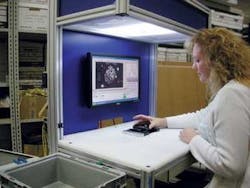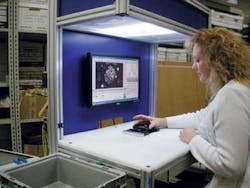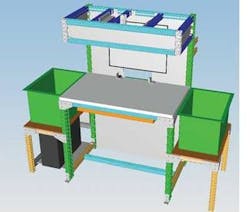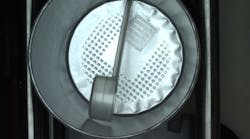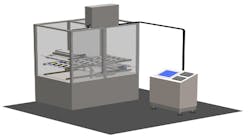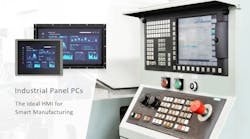A discussion with Lou Fetch, Performance Automation
VSD:Please describe your company and its services. What is the origin of your company?
Fetch: Performance Automation is a system integrator, specializing in machine-vision inspection solutions. Our roots came from the factory automation distribution business. As a result, we recognized that our customers had a critical need for machine-vision integration to improve their productivity and their competitiveness in a changing world economy.
VSD: What technologies and components do you use for your applications? How often do you evaluate competing technologies?
Fetch: Lately, the majority of our applications have been PC-based solutions with higher-resolution cameras and with one axis of motion. We have used motion to accurately position the inspection item under the camera; other times we will present the camera to the inspection item. We have begun moving away from FireWire and using more GigE cameras. National Instruments Vision Builder software has solved several of our machine-vision and control applications, but we have also used custom C# programming to solve specific applications.
Using new technology for the first time presents a certain amount of risk to the overall success of the project. Customer applications have challenged us to expose new technologies or techniques. New approaches could also translate to a more robust solution. Using established vendors with a solid reputation for support, quality products, and service will limit that risk.
VSD:How do you approach a new application? Do you work with OEMs or other systems integrators?
Fetch: Some project opportunities are with clients using machine vision for the first time or who are relatively new to the technology. We take the time to walk them through the process of a successful application. It is essential for us to take a customer sample, acquire an image, and use basic vision tools to demonstrate the feasibility of the application, and assess and then discuss the risk.
Our projects also provide for customer training not only for the delivered solution but how to apply machine vision in general to ensure that they have basic knowledge for simple troubleshooting of the installed project. In addition, the training allows the customer to better identify other practical applications for machine vision in their operation.
In our fixed-cost project proposals, we often provide a 3-D model of the system layout with a detailed description of the deliverables. We refer to this approach as “Concept to Solution.” 3-D models of recent projects have helped the client visualize what the solution will look like. A set of fabrication drawings can then be generated from these models (see Fig. 1).
We are not currently using CAD with motion or to model lighting. However, at a technical conference last August we saw a presentation on the use of software to model machine-vision lighting and lenses, and we are curious to learn more. It is not uncommon for seemingly simple applications to take hours or more worth of effort to work out the light and lens details. Software tools would certainly be a timesaver.
Fetch: To protect our customers’ interests, we use commercially available products from vendors that are industry leaders. Commercially available products will also give the customer vendor options. For instance there are several vendors that can supply FireWire or GigE cameras. Major vendors also often have an upgrade path when a product does become obsolete.
VSD: In which areas do you see the most growth? What are users demanding from you in the design of new systems?
Fetch: One common element of recent projects has been higher-resolution cameras and statistical process control (SPC) reporting. We use standard SPC tools to show our clients what their process is capable of producing before we set pass/fail machine-vision criteria. This helps the client understand where to set machine-vision limits and ultimately assists them in improving their process. This also allows our clients to identify process improvements and then measure and quantify those improvements.
Our typical SPC GUI will have main tabs that display the current image, last failed image, and a statistics tab. The statistics tab has additional tabs that display information about a process variable. Each process variable is recorded for common process statistics such as Avg., Std. Dev., Max and Min values, Median, and capabilities CP and CPK. The second tab for each process variable has a histogram of the measured variable.
After the major variables are identified and the customer has inspected a suitable sample size of parts, we then turn the data into information they can use. This statistical process information can now be used to set the accept/reject limits for the vision tools. One customer has used this information to improve their molding process.
VSD: In which geographical areas do you work?
Fetch: We are a machine-vision integrator located in southern Ohio. Our primary marketing area is about a 500-mile radius. Although, for our global clients, we have on occasion traveled outside that radius, we have not executed a project outside of the US yet.
VSD: What new markets and technologies do you see for your company in the future?
Fetch: Honestly, there is currently enough business in the traditional markets that have been generating business for us. There are still plenty of applications to inspect molded and machined parts and labels, for instance.
One interesting trend of late has been inquiries for machine vision in analytical applications. One professor asked us about using machine vision to monitor the activity of fish embryos in a Petri dish. Another client asked about using machine vision to quantify the amount of a compound that fluoresced under UV light.
An emerging technology that is intriguing to us is time-of-flight cameras. Also, thermal imaging offers opportunities in certain markets.
Lou Fetch is with Performance Automation (Loveland, OH, USA; www.performanceautomationinc.com), which was established in 2005. Editor in chief Conard Holton talked to him about inspection systems and implementing SPC practices.
